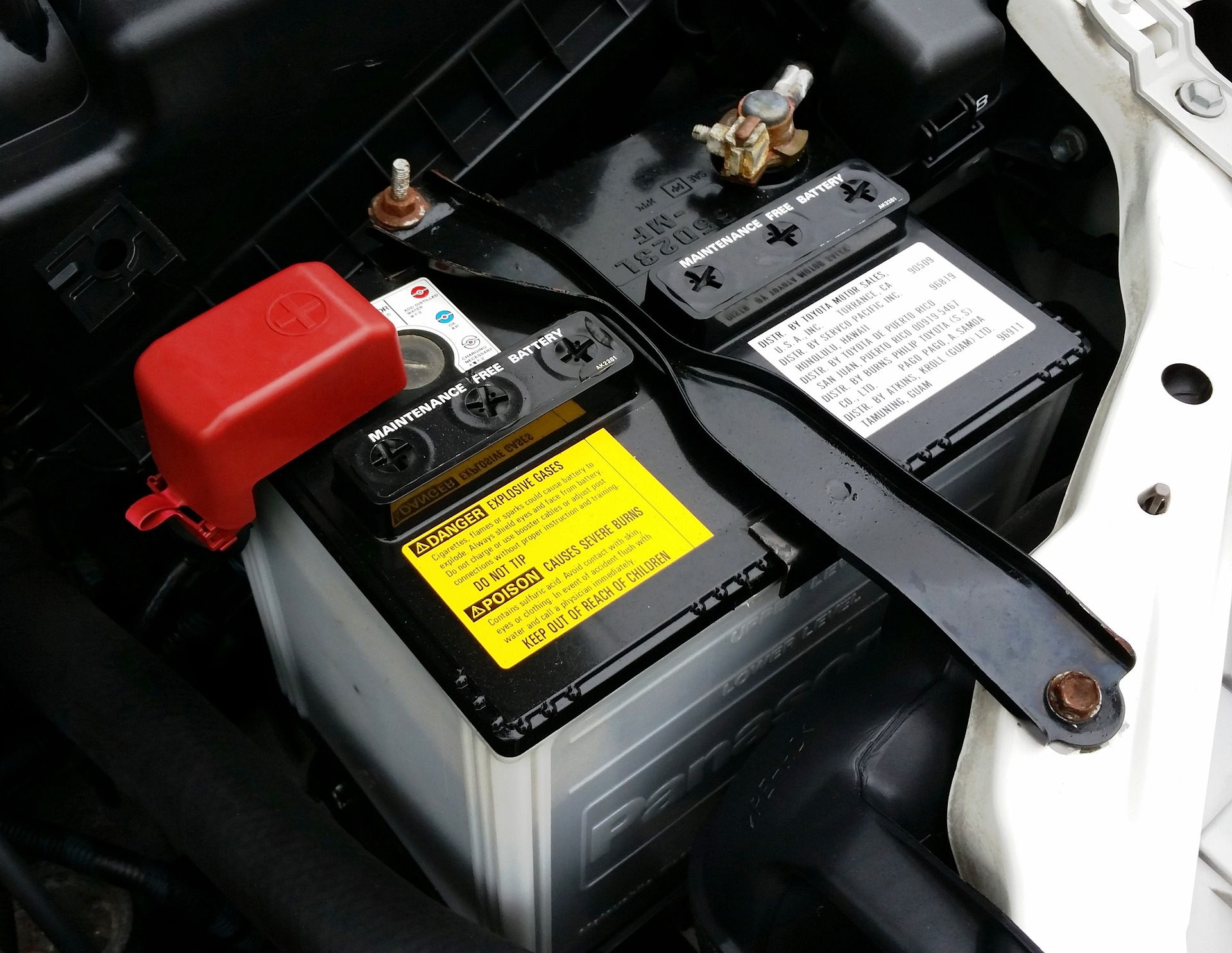
Image by Bruce Emmerling from Pixabay
What Is Car Battery Corrosion?
Car battery corrosion is the buildup of unwanted material on the battery parts, including the terminals, posts, or cables. It usually looks like green, blue, or white crystals caked around the battery elements — a bit like someone spilled laundry or dishwasher detergent powder on the battery.
The encrustation can be very minimal, or it can cover the terminals, depending on the cause and how advanced the problem is. If left untreated, the faulty battery that results from corrosion could leave you stranded or shorten the battery’s lifespan, costing you money. The terminals can eventually break off, making the battery useless.
What Are Some Common Car Battery Corrosion Symptoms?
What if you can’t see your vehicle’s battery (see more on accessibility concerns below)? Or what if the corrosion is just starting to form? What other signs of battery corrosion might you notice?
- Difficulty starting the engine
- Clicking and no turnover when turning the ignition
- Dim lights or other electrical malfunctions
- Leaking fluid on the engine or below the vehicle
What Are the Causes of Car Battery Corrosion?
One of the top causes of car battery terminal corrosion is the chemical reaction that occurs naturally with battery use. Battery acid can react with metal terminals, accelerated by hydrogen, water, and salt in the air. This precipitates the formation of lead sulphate crystals (corrosion). Normally, this happens in minute amounts over years, which is why batteries have a lifespan of about 2-5 years.
In addition to aging, there are other factors that can hasten battery corrosion, such as:
- Overfilled electrolytes in lead acid batteries
- A damaged battery that results in leaking
- Overcharging or undercharging of the battery
- Operating the vehicle at excessively high temperatures
The last point means drivers are at higher risk of battery corrosion during hot summer months.
Should You Try to Treat Car Battery Corrosion on Your Own? No!
There are thousands of well-intentioned but misguided articles on the internet instructing vehicle owners how to remove battery corrosion and clean the battery terminals. These treatments typically use items you can find at home, like baking soda or petroleum jelly. Some suggest using commercial battery cleaners. However, we do NOT recommend DIY car battery treatments for a number of reasons.
First, you must be certain what is causing the corrosion before you can remove it. Different types of chemical buildup require different chemicals to strip them away. You could inadvertently do more damage by using the wrong cleaning agent.
Second, there is a safety issue involved. You could sustain chemical burns if you’re not careful or don’t know what’s causing the corrosion. You might also inadvertently cause sulphate crystals to spill on the ground, which would be harmful to kids and pets.
You must also be sure the battery is disconnected in order to avoid the risk of electric shock. This may not even be possible if your battery is not accessible. In many Mercedes-Benz vehicles, for example, the battery is located under the front passenger seat, and gaining full access to it requires removing the seat — not something the average driver is equipped to do and do safely.
You don’t want to damage the airbag mechanisms, among other concerns, and you must ensure the airbags are working properly again when you’re done. You may also wind up voiding the warranty on your battery or your vehicle if you try to do the work yourself. Obviously, this is something all drivers want to avoid.
Finally, removing car battery corrosion at home is a temporary solution. You need to know what is causing the corrosion in the first place, which may be more than simply a battery issue. An expert mechanic should assess your electrical system to make a diagnosis, and then together you can create a plan for a solution, including addressing any other parts related to the battery, like the starter and alternator.
Car Battery Corrosion Prevention: Best Practices for Canadian Drivers
Now that you know what causes corrosion on a car battery, it’s time to learn how you can take steps to prevent this unwanted problem.
Keep an eye on engine temperatures, particularly during summer, so you’re not running too hot. If your vehicle is in an accident, have the battery checked to make sure it wasn’t damaged.
The best thing you can do for your battery is to stay on top of routine maintenance with your mechanic, as recommended by your garage and your vehicle owner’s manual. This is especially important in areas with high humidity and salt air, such as western Canada. Ask about electrolyte maintenance, if your battery requires it. Your mechanic can also assist with protective coatings, anti-corrosion pads, and copper compression terminals that resist corrosion.
Don’t put off making an appointment with the shop if you see the battery light illuminated on your dashboard or notice any of the symptoms listed above.
If you must drive before your mechanic’s appointment, consider carrying a portable jumper or jumper cables and know how to jump-start your car in an emergency. Many insurance policies offer roadside assistance for a dead battery, but you can’t always rely on them in bad weather, in remote locations of British Columbia outside the city of Vancouver, or during heavy traffic times of the day.
Be aware that you may not be able to jump-start your vehicle at all if battery corrosion is bad enough to prevent electrical charge from reaching its destination. Therefore, don’t delay in scheduling a visit to the mechanic at the first signs of battery corrosion, and you can usually avoid these problems altogether.
